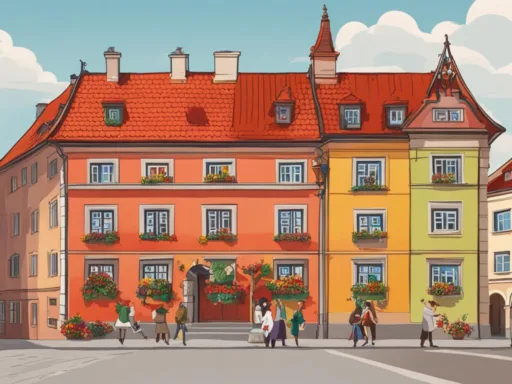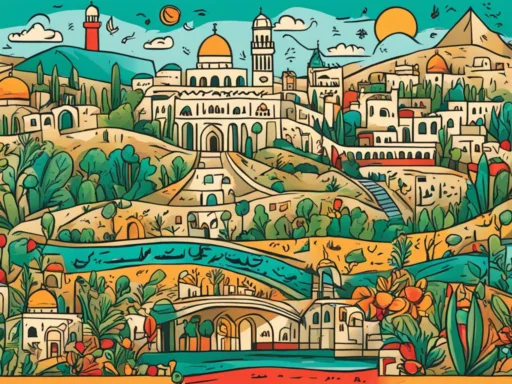The nation of Bosnia and Herzegovina boasts an impressive tapestry of linguistic variation that eloquently tells its storied past. Here, the spoken word is not merely a means of communication but also an embodiment of the rich cultural interweave that defines this heart-shaped country. In the bustling marketplaces of Sarajevo, the quiet towns dotting the countryside, and the scenic cities perched along the Dinaric Alps, one can hear a symphony of languages spoken in Bosnia and Herzegovina, each adding its unique note to the country’s harmonious diversity.
A harmonious trio of official languages Bosnia and Herzegovina embraces – Bosnian, Serbian, and Croatian – reflects the country’s commitment to represent all its people. While these languages share Slavic roots and bear close resemblance to one another, they are proudly spoken by distinct ethnic groups, giving voice to the array of narratives that have shaped the nation. The linguistic diversity Bosnia and Herzegovina nurtures is intrinsic to its identity, enabling a vibrant dialogue between cultures and communities.
Whether etched on historical monuments, articulated in daily conversation, or taught in classrooms, the languages spoken in Bosnia and Herzegovina are not merely a form of communication but are vital to the rich heritage and unity of its people. As travelers wander through its alleys or locals break bread, whether in the aromatic kitchens or within the sepia-toned monasteries, the language remains a steadfast witness to the endurance and evolution of this endearing land.
Key Takeaways
- Bosnia and Herzegovina is a socio-cultural mosaic highlighted by its linguistic diversity.
- Three official languages coexist: Bosnian, Serbian, and Croatian, each marking a respect for ethnic identities.
- The linguistic landscape here is rooted in the region’s complex history, including influences from the Ottoman Empire to the Austro-Hungarian rule.
- The Latin and Cyrillic alphabets are both used, reflecting historical ties and modern preferences.
- Language in Bosnia and Herzegovina serves as more than a tool for communication—it’s a celebration of cultural heritage.
The Linguistic Landscape of Bosnia and Herzegovina
Embarking on a journey through the linguistic landscape of Bosnia and Herzegovina unveils a history-rich tapestry of tongues that narrate the nation’s storied past. Here, amid the interlacing threads of cultural diversity, stand the three co-official languages—Bosnian, Croatian, and Serbian—each serving as a testament to the country’s multifaceted identity. The languages spoken in Bosnia and Herzegovina resonate with the echoes of history, each colored by the experiences and traditions of the ethnic groups that embrace them.

An Overview of Bosnia and Herzegovina’s Multilingualism
In the heart of the Balkans, Bosnia and Herzegovina’s multilingualism is as natural as the river’s flow through its valleys. The Bosnian language, along with Croatian and Serbian, forms a linguistic trinity that reflects the country’s historical crossroads. With distinct dialects and alphabets, these languages encapsulate the essence of the nation’s robust linguistic heritage Bosnia and Herzegovina prides itself on.
How History Shaped the Languages of Bosnia and Herzegovina
The history of Bosnia and Herzegovina is a palimpsest, with layers of linguistic influence telling tales of conquest and coexistence. The Ottomans weaved Arabic and Turkish loanwords into the Bosnian language, leaving indelible marks of their reign. Meanwhile, the Austro-Hungarian Empire’s influence persisted in the lexicon and syntax of the region’s tongues. The Serbo-Croatian continuum, consisting of Bosnian, Croatian, and Serbian, remains a vivid demonstration of shared origins and divergent linguistic paths, often reflecting the region’s religious and cultural landscapes.
Understanding the Official Language Policy in Bosnia and Herzegovina
As a beacon of linguistic equality, the language policy Bosnia and Herzegovina upholds enforces the inalienable linguistic rights of its people. It accords equal status to the Bosnian, Serbian, and Croatian languages, enshrining citizens’ rights to their native tongue. Language education Bosnia and Herzegovina promotes is tailored to this trilingual scheme, fostering an educational foundation that supports mutual respect and understanding among its diverse inhabitants.
Languages Spoken in Bosnia and Herzegovina
The cultural tapestry of Bosnia and Herzegovina is richly woven with the strands of its linguistic diversity. The bustling streets echo with the sounds of conversations in not just the official languages of Bosnian, Serbian, and Croatian, but also in the varied tongues of its minority languages. This confluence of languages within Bosnia and Herzegovina is a reflection of the country’s vibrant cultural history and the acceptance and celebration of its diverse populations.

While the Bosnian language, along with Serbian and Croatian, garners the status of officialdom, it’s the mosaic of minority languages that add an additional layer of complexity and charm to the nation’s linguistics. The minority languages of Bosnia and Herzegovina, while not as widely spoken, are critical fragments that complete the picture of the nation’s heritage. They are not only languages of communication but also vehicles carrying the traditions, memories, and identities of the communities.
- Bosnian: Written in both Latin and Cyrillic, it bears the legacy of Eastern Herzegovinian dialects.
- Serbian: An official language frequently written in Cyrillic, it shares linguistic traits with Bosnian.
- Croatian: A member of the official triad, it’s typically written in Latin script and showcases unique lexical features.
The inclusion and recognition of minority languages are essential for a true representation of the linguistic picture in Bosnia and Herzegovina. It is not only a matter of respecting individual rights but also honoring the country’s commitment to fostering an environment of cultural and linguistic inclusivity.
| Language | Script Used | Official Status | Native Speakers |
|---|---|---|---|
| Bosnian | Latin and Cyrillic | Co-official in Bosnia and Herzegovina | Approx. 2.6 million |
| Serbian | Cyrillic and Latin | Co-official in Bosnia and Herzegovina | Estimated 1.086 million in Bosnia and Herzegovina |
| Croatian | Latin | Co-official in Bosnia and Herzegovina | Numerous speakers in Bosnia and Herzegovina |
The narrative that unfolds through the languages spoken across Bosnia and Herzegovina is one marked by historical depth and coherent co-existence, infusing the modern state with its distinctive character. With each language contributing its unique melody, the linguistic ensemble of Bosnia and Herzegovina plays on harmoniously, echoing through the mountains and valleys, telling stories of past and present, while always looking forward to the future.
The Bosnian Language: History and Characteristics
As we delve into the essence of the Bosnian language, we uncover a rich heritage shaped by a confluence of cultures. It is a language that evokes the spirit of Bosnia and Herzegovina’s intricate history, blossoming through periods of sovereignty and foreign dominion. With an ever-present echo of its past, the Bosnian language stands as a beacon of the nation’s resilience and diversity, bound tightly to the Shtokavian dialect and Eastern Herzegovinian sub-dialects.
Exploring Bosnian’s Linguistic Roots and Shtokavian Dialect
The heart of the Bosnian language pulsates with a rhythm rooted deeply in the Shtokavian dialect, particularly the Eastern Herzegovinian variant. This dialectal soil is shared with its linguistic kin, Croatian and Serbian, weaving a vibrant thread through the Serbo-Croatian continuum. Such shared foundations illustrate the interconnected nuances of these languages while also celebrating the individual identity that Bosnian has carved for itself through a tapestry of historical events and linguistic evolution.
Bosnian Alphabets: Latin and Cyrillic Scripts
Illustrative of Bosnia and Herzegovina’s dual historical influence, the Bosnian language is articulated through two alphabets: the Latin script and the Cyrillic script. Latin script Bosnian graces everyday use, facilitating seamless communication within and across borders. Contrastingly, Cyrillic script Bosnian honors the past, continuing to find its place in official documents and scholarly works. Together, these scripts encapsulate the duality of Bosnian’s alphabetic heritage, bridging the gap between its historical past and modern-day presence.

Influence of Other Languages on Bosnian Vocabulary
Bosnian vocabulary is a colorful palette enriched by the intricate designs of words borrowed from Arabic, Persian, and Ottoman Turkish languages. The intricate Arabic loanwords in Bosnian, alongside the Persian loanwords in Bosnian, display the intricate artistry of Islamic scholarly tradition, while the Ottoman Turkish influence on the Bosnian language reflects a time when Bosnia was a blossoming garden within an expansive empire. These contributions have shaped Bosnian into a unique linguistic entity that not only thrives within the Western South Slavic subgroup but also resounds with an echo of its vast interactions with different cultures and languages.
Croatian and Serbian in Bosnia and Herzegovina
The linguistic fabric of Bosnia and Herzegovina is enriched not only by the Bosnian language but also by the profound presence of the Croatian language Bosnia and Herzegovina and the Serbian language Bosnia and Herzegovina. These languages are integral strands of the region’s communicative weave, each bearing its own unique thread of history within the broader tapestry of the Serbo-Croatian language family.
Inhabitants often express affection for the melodious Ijekavian accent closely associated with the Croatian language. This variant utilizes the Latin alphabet exclusively and is distinguished by lexical nuances that set it apart from its linguistic relatives. It converses fluently with the Bosnian language, participating in a shared dialectical space, yet preserving its individual lexical identity.
Similarly, the Serbian language weaves its narrative through both Cyrillic and Latin texts, reflecting centuries of cultural fusion and fission. Traditionally echoing the Ekavian pronunciation, Serbian in Bosnia and Herzegovina aligns closely with other regional languages while preserving its own voice within the pluricentric Serbo-Croatian continuum.

The interplay between Croatian and Serbian in Bosnia and Herzegovina is not solely a matter of syntax or vocabulary. It reverberates through educational policies, media, and everyday interactions, showcasing the country’s pluralistic ethos. Discourse in these languages serves as the bedrock upon which the nation’s interethnic tapestry is woven, promoting cultural cohesion even as it celebrates diversity.
| Language | Alphabets Used | Pronunciation Variant | Cultural Significance |
|---|---|---|---|
| Croatian | Latin | Ijekavian | Exemplifies western lexical influences & Latin literary tradition |
| Serbian | Cyrillic and Latin | Ekavian and Ijekavian | Reflects dual alphabetic heritage & Eastern Orthodox tradition |
Understanding the linguistic dynamic of these languages in the nation’s fabric requires a look beyond the superficial similarities they share. It demands recognition of the profound ways these languages contribute to the cultural and historical conversation of Bosnia and Herzegovina.
Minority and Immigrant Languages in Bosnia and Herzegovina
The canvas of Bosnia and Herzegovina’s national identity is splashed with the vibrant hues of its linguistic offerings, going beyond the predominant Serbo-Croatian derivatives to include an array of immigrant languages Bosnia and Herzegovina has welcomed. These non-native languages, each with its unique phonetic melody, enrich the cultural heritage of this Balkan nation and highlight the nuanced process of linguistic integration Bosnia and Herzegovina experiences.

Embracing the chords of multiculturalism, Bosnia and Herzegovina’s linguistic tapestry is textured with the variegated threads of languages spoken by those who arrived from distant lands. These linguistic threads are woven into the country’s social fabric, portraying the story of its evolving identity.
The Role of Immigrant Languages and Their Speakers
The significance of immigrant languages Bosnia and Herzegovina accommodates is profound, as they provide a glimpse into the individual journeys and collective histories of its people. The Bulgarian language in Bosnia and Herzegovina, for example, stands as a testament to the deep-rooted connectivity within the Balkans, with a speaker base solidified by time and proximity. Whether it’s through enduring community networks or the influx of new speakers, these languages serve as vital instruments for the preservation of their respective cultures and the promotion of diversity.
Bulgarian, Turkish, and other non-native tongues
Intricately interwoven with the national lexicon are the Turkish loanwords in Bosnian – echoes of a past Ottoman influence that resonate today. The resilience of these words within the vernacular underlines the extensive historical and cultural exchanges that have shaped the Bosnian language over centuries. Similarly, the integration of Bulgarian, Turkish, and other non-native languages Bosnia and Herzegovina hosts mirrors the cross-cultural dialogues and enhances the multilingual narrative that the nation proudly tells.
| Immigrant Language | Speakers in Bosnia and Herzegovina | Influence on Local Language |
|---|---|---|
| Bulgarian | Largest community among immigrant languages | Cultural and linguistic connectivity within the Balkans |
| Turkish | Significant historical presence | Numerous loanwords in Bosnian language |
| Italian | Smaller, yet impactful speaker base | Cultural exchange and tourism-related interaction |
| Ukrainian | Established immigrant community | Preservation of Ukrainian culture and traditions |
| German | Presence due to historic migration patterns | Professional and academic exchanges |
The subtle harmonies of these non-native languages blend with the everyday discourse adding a dimensional richness to the cultural symphony. Thus, immigrant languages, through integration and retention of unique linguistic characteristics, parallel the narrative of Bosnia and Herzegovina’s continually diversifying society.
Conclusion
The linguistic identity of Bosnia and Herzegovina is a vibrant embodiment of the nation’s intricate past and its rich cultural diversity. With an array of languages spoken within its borders, the country offers a unique window into the powerful role language plays in defining a nation’s heritage and fostering community ties. The coexistence of Bosnian, Croatian, and Serbian as official languages, each respected and preserved, underscores a history of mutual recognition and cultural richness.
It is this mosaic of linguistic diversity that illustrates the compelling story of Bosnia and Herzegovina. From the echoes of the Ottoman Empire heard in the numerous Turkish loanwords in Bosnian to the varied immigrant languages that contribute to the country’s evolving cultural tapestry, this Balkan state is a testament to the longevity of linguistic traditions as markers of identity and unity.
As we reflect on the languages spoken in Bosnia and Herzegovina, we see not merely a patchwork of dialects and alphabets but a continuing narrative that speaks volumes about the nation’s resilience and its commitment to cultural inclusivity. Language, in its purest form, transcends mere communication – it is an instrument of expression that connects individuals, shapes societal values, and preserves the ever-evolving story of human civilization.
FAQ
What Languages are Spoken in Bosnia and Herzegovina?
Bosnia and Herzegovina is home to a rich linguistic tapestry that includes three official languages: Bosnian, Serbian, and Croatian. These languages are complemented by several minority and immigrant languages that contribute to the country’s linguistic diversity.
How Has History Influenced the Languages Spoken in Bosnia and Herzegovina?
The Ottoman Empire’s rule resulted in the introduction of Arabic and Turkish loanwords into the Bosnian language, while the Austro-Hungarian influence left its own linguistic marks. Moreover, the presence of the Serbo-Croatian language continuum highlights the shared and divergent paths within the nation’s linguistic history.
What is the Official Language Policy in Bosnia and Herzegovina?
Bosnia and Herzegovina’s official language policy promotes linguistic equality by recognizing the Bosnian, Serbian, and Croatian languages equally. The policy ensures that citizens have the right to use their language and script, and language education reflects this trilingual approach.
What are the Key Characteristics of the Bosnian Language?
The Bosnian language is rooted in the Shtokavian dialect, specifically the Eastern Herzegovinian sub-dialect. It employs both the Latin and Cyrillic scripts, and it is distinguished by a significant number of loanwords from Arabic, Persian, and Ottoman Turkish, which highlight its historic cultural connections.
How are the Croatian and Serbian Languages Integrated into Bosnia and Herzegovina’s Linguistic Landscape?
Croatian, primarily written in the Latin alphabet and spoken in the Ijekavian pronunciation, and Serbian, which uses both Latin and Cyrillic alphabets and is mainly spoken in the Ekavian pronunciation, are integral parts of Bosnia and Herzegovina’s linguistic ecosystem. These two languages share several dialectal features with Bosnian.
What Role Do Immigrant Languages Play in Bosnia and Herzegovina?
Immigrant languages contribute to the country’s cultural and linguistic diversity. Bulgarian, Italian, Ukrainian, Turkish, and German are among the languages spoken by distinct communities, reflecting Bosnia and Herzegovina’s historical migration patterns and the impact of globalization.
What is the Impact of Minority and Immigrant Languages on Bosnia and Herzegovina’s Cultural Fabric?
Minority and immigrant languages play a significant role in enriching Bosnia and Herzegovina’s cultural fabric. They provide a sense of identity and community for their speakers and contribute to the broader narrative of the country’s multicultural legacy.






